D-Day
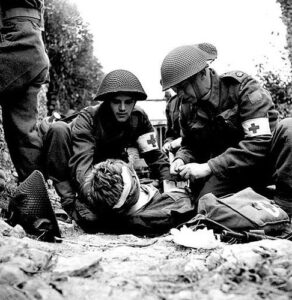
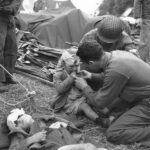 Not every soldier that stormed the beaches at Normandy, France on D-Day (June 6, 1944), carried a gun…or any other weapon. I’m not saying these men were more brave that their armed counterparts, because all of those men were targets. They all knew, going in that it was very unlikely that they would come home again. They were running onto an armed beach in broad daylight, with the plan of taking down the strongholds that existed there. The main difference between the armed soldiers and the medics was the inability to protect themselves. The medics weren’t there to fight. They were there to save. The were the only thing standing between the armed soldiers and certain death. Just the thought of that brings tears to my eyes. All the men who stormed those beaches faced almost certain death, and yet they knew they had to go. They couldn’t live with themselves if they didn’t do their best, be it killing the enemy soldiers or saving the wounded soldiers.
Not every soldier that stormed the beaches at Normandy, France on D-Day (June 6, 1944), carried a gun…or any other weapon. I’m not saying these men were more brave that their armed counterparts, because all of those men were targets. They all knew, going in that it was very unlikely that they would come home again. They were running onto an armed beach in broad daylight, with the plan of taking down the strongholds that existed there. The main difference between the armed soldiers and the medics was the inability to protect themselves. The medics weren’t there to fight. They were there to save. The were the only thing standing between the armed soldiers and certain death. Just the thought of that brings tears to my eyes. All the men who stormed those beaches faced almost certain death, and yet they knew they had to go. They couldn’t live with themselves if they didn’t do their best, be it killing the enemy soldiers or saving the wounded soldiers.
Most soldiers are trained to shoot, fight, and kill the enemy, but a combat medic is very different. He is trained to do the exact opposite. The medics had no guns. They went in to “battle” unarmed, and their mission wasn’t to attack the enemy, it was to dodge the bullets that were flying everywhere and get to the soldiers who had been wounded. Then they tried to get them off the battlefield so they could treat their wounds, and hopefully save their lives. Sometimes, they had to treat them where they were. Bullets don’t distinguish between a soldier and a medic.
There are, of course, far too many medics who have bravely gone in to try to save other soldiers at the risk of losing their own lives. While the armed soldiers fight the battles, medics pick up the pieces during and after the battle. It’s the medics who gather up the belongings of those they cannot save, so they can be returned to the families. They don’t really have much time before they must move on to the next wounded soldier, and so often they grab the dog tags, because it is the only true way to know who this soldier was. It’s the only way to let their family know that their brave soldier gave the ultimate sacrifice in battle.
My dad, Staff Sergeant Allen Spencer was a top turret gunner and flight engineer in one of the B-17s that 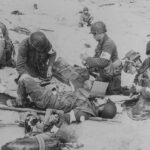
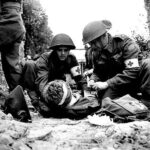 provided cover for the men as they stormed the beaches of Normandy that fateful day. My uncle, Jim Wolfe was one of the men below, storming the beaches. I don’t know if they knew each other then, but they would later, when my Uncle Jim married my dad’s sister, Ruth. It’s very hard to think about this battle, because so many lives were lost. I don’t know how anyone made it onto that beach without getting pelted with a barrage of bullets, but I am thankful for the medics who were there to try to pick up the pieces. Today marks the 80th anniversary of D-Day. From a grateful nation, we honor all who fought in that horrific battle. Very brave men all!!
provided cover for the men as they stormed the beaches of Normandy that fateful day. My uncle, Jim Wolfe was one of the men below, storming the beaches. I don’t know if they knew each other then, but they would later, when my Uncle Jim married my dad’s sister, Ruth. It’s very hard to think about this battle, because so many lives were lost. I don’t know how anyone made it onto that beach without getting pelted with a barrage of bullets, but I am thankful for the medics who were there to try to pick up the pieces. Today marks the 80th anniversary of D-Day. From a grateful nation, we honor all who fought in that horrific battle. Very brave men all!!
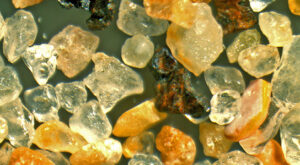 I had never heard the expression, “war sand” before, but when I think about it, the presence of it makes perfect sense. It would be impossible to have any kind of a battle and not leave behind spent bullets, as well as bits of shrapnel from bombs littering the battlefield. In the case of the D-Day Battle, there were more that 5,000 tons of bombs that littered the beaches of Normandy. The beaches were literal chaos, and it was all they could do to rescue the wounded, recover the bodies, and remove the equipment, much less save bits of metal and spent bullets left behind. On D-Day, more than 5,000 tons of bombs were dropped by the Allies on the Axis powers as part of the prelude to the Normandy landings…and then there was the bullets and such that hit the beaches during the battle.
I had never heard the expression, “war sand” before, but when I think about it, the presence of it makes perfect sense. It would be impossible to have any kind of a battle and not leave behind spent bullets, as well as bits of shrapnel from bombs littering the battlefield. In the case of the D-Day Battle, there were more that 5,000 tons of bombs that littered the beaches of Normandy. The beaches were literal chaos, and it was all they could do to rescue the wounded, recover the bodies, and remove the equipment, much less save bits of metal and spent bullets left behind. On D-Day, more than 5,000 tons of bombs were dropped by the Allies on the Axis powers as part of the prelude to the Normandy landings…and then there was the bullets and such that hit the beaches during the battle.
These days, scientists estimate that 4% of the Normandy beaches are made up of shrapnel from the D-Day Landings. They have studied the sand on the beaches of Normandy, and they’ve found microscopic bits of smoothed-down shrapnel from the landings. The sand on the Normandy beaches is known as “war sand,” which is defined as “sand that is a result from wartime operations.” I had heard of beaches that are made of glass that has been rubbed smooth by the water against the ground, but I hadn’t ever thought about the water being able to smooth the sharp bits of shrapnel to make them smooth. Nevertheless, the beaches of Normandy are 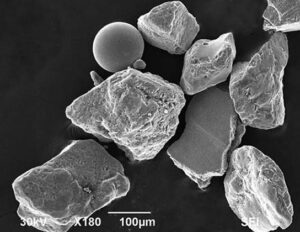 covered in a fine dust created from particles deposited there during or right before the D-Day operations of World War II. The grains are hidden among the beaches of the Normandy. It makes me wonder how many other beaches have shrapnel and bullets as a secret part of their makeup.
covered in a fine dust created from particles deposited there during or right before the D-Day operations of World War II. The grains are hidden among the beaches of the Normandy. It makes me wonder how many other beaches have shrapnel and bullets as a secret part of their makeup.
Earle McBride, a geologist from the University of Texas at Austin, figures the sands shrapnel level at 4%. That doesn’t seem like much, but considering the years since D-Day, and the number of people who have walked those beaches, possibly looking for closure concerning lost loved ones, 4% is quite a bit. One might wonder how he could have come to that conclusion, but apparently the sand-sized fragments of steel are magnetic, making them easily discernible under a microscope. Of course, there are still relics from the battle. The artificial landscape of eroded machinery is still detectable using special instruments in the coastal dunes.
The shrapnel content of the beaches will eventually disappear. It is estimated that at the present rate of deterioration, the magnetic particles will probably be wiped from the sands in another 100 years. The shrapnel is subject to waves, storms, and rust, which will wipe these spherical magnetic shards from the coasts.  Strangely, Earle McBride didn’t set out to find these shards, but a visit to Omaha Beach in 1988 resulted in the discovery of these tiny remnants of shrapnel. I wonder how he noticed the shrapnel. Oddly, the shards were collected 20 years ago and only analyzed recently. Why did it take so long to examine them? Of course, I have answered my own question. While he may have known what he had, it is possible that he really didn’t or at least didn’t know the significance of what he had. He might have simply collected the sand as a keepsake of his visit. Nevertheless, upon examination, the samples revealed that the jagged-edged grains had a metallic sheen and a rust-colored coating. The angular grains proved to be magnetic…they proved to be shrapnel from that long ago battle.
Strangely, Earle McBride didn’t set out to find these shards, but a visit to Omaha Beach in 1988 resulted in the discovery of these tiny remnants of shrapnel. I wonder how he noticed the shrapnel. Oddly, the shards were collected 20 years ago and only analyzed recently. Why did it take so long to examine them? Of course, I have answered my own question. While he may have known what he had, it is possible that he really didn’t or at least didn’t know the significance of what he had. He might have simply collected the sand as a keepsake of his visit. Nevertheless, upon examination, the samples revealed that the jagged-edged grains had a metallic sheen and a rust-colored coating. The angular grains proved to be magnetic…they proved to be shrapnel from that long ago battle.
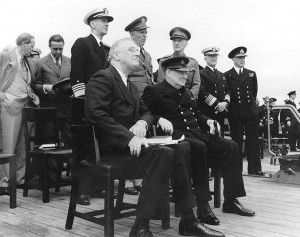
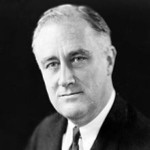
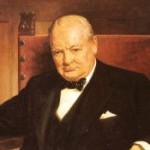 In a military operation, especially as part of a war, absolute secrecy is vital. Those involved with the planning have to know that they can trust everyone who is around them. One of the most important operations of World War II was the D-Day attack…Operation Overlord. Success was vital, and failure was simply not an option, no matter how many men were lost. The attack on Pearl Harbor had finally drawn the United States into World War II, and now we were in it to win it.
In a military operation, especially as part of a war, absolute secrecy is vital. Those involved with the planning have to know that they can trust everyone who is around them. One of the most important operations of World War II was the D-Day attack…Operation Overlord. Success was vital, and failure was simply not an option, no matter how many men were lost. The attack on Pearl Harbor had finally drawn the United States into World War II, and now we were in it to win it.
The success of any mission is found in the planning, so in August 1943, Franklin D Roosevelt and Winston Churchill met in Quebec for the first of two meetings code-named “Quadrant.” Technically, the meeting was the first of two “Quebec Conferences.” The meetings couldn’t even officially talk about the name of the actual operation, “Operation Overlord, which was later known as D-Day to the world. The Americans and the Brits had differences of opinion as to just how the operation was to be handled, but in order to make this operation work, they would have to be in complete agreement, and the mission would have to be kept completely covert!! No one could know the details.
Everyone, from the top men down to the paper supplier was screened to make sure of their loyalties. No stone was left unturned. If any information was leaked, thousands of men could die, and the fate of the world could have been severely compromised. Nevertheless, something was “missed” somehow. A young Canadian named Émile Couture was in charge of stationery supplies that fateful day, and in reality, he had no intention of being a traitor or playing any other nefarious part in the leak of information into the operation. Nevertheless, he managed to walk out of those meetings with the tactical plans for the invasions. It wasn’t even accidental…exactly.
Roosevelt and Churchill were excellent strategists, and their very detailed plans were perfectly laid out. The operation was going to be an amazing success. Now, all they had to do was to keep everything secret until the actual day, as yet unnamed, of the operation. The plans included detailed listings of Allied military assets to be used in the landings…the number of planes, combat cars, ships, and ground soldiers. They only had to keep it very quiet, because the leak of this information could have turned the tide of the war in favor of the Axis powers, and had that happened, our world would be vastly different even from the strange world we are experiencing today. Sergeant Major Émile Couture had been tasked with cleaning up after the meetings and instructed to make sure nothing was left behind.
Couture was doing his job in a meticulous fashion, but while cleaning an office on the third floor of the hotel, he discovered a leather portfolio that was inscribed “Churchill-Roosevelt, Quebec Conference, 1943. Maybe he thought it was just an empty portfolio, and so thought he could actually have an amazing souvenir of such a monumental meeting. Just think of the stories he could tell his children and grandchildren about the time he got to help out with such an important meeting between two of the most important men if his time. History doesn’t really tell us what he was thinking, but he decided to keep the portfolio as a souvenir without realizing what was actually in the portfolio.  Couture walked out of the Château Frontenac without anyone being any the wiser and drove to the cottage where he was living with his cousins in Lac-Beauport just a few miles outside of Quebec City. Then he took time to examine his “treasure” only to find that he could actually be tried for treason. Couture was more than frightened. He was terrified, and he hid the files under his mattress overnight.
Couture walked out of the Château Frontenac without anyone being any the wiser and drove to the cottage where he was living with his cousins in Lac-Beauport just a few miles outside of Quebec City. Then he took time to examine his “treasure” only to find that he could actually be tried for treason. Couture was more than frightened. He was terrified, and he hid the files under his mattress overnight.
In the morning, knowing that he would have to face the music, he took the portfolio and its files to his superior, Brigadier Edmond Blais. Blais told Couture to go home and wait. He would be dealt with in the morning. Couture could have been put in prison for the remainder of the war in order to make certain that he did not leak the information he had seen. He was, after all, a low-ranking soldier, and shouldn’t have access to such top-secret information. Instead, he was sent home after being questioned by Scotland Yard and the FBI.
Whether Couture was terrified to say anything, or just an honorable soldier, he never leaked the information he had seen. Blais must have liked Couture, because he sent a letter on August 28, 1943, in which he recommended the Sergeant Major Émile Couture be awarded “the greatest accomplishment that can be given an NCO (non-commissioned officer).
On June 6, 1944, the Allies staged the largest amphibious military landing in history. Always remembered as D-Day, Operation Overlord saw 150,000 troops hit the beaches of Normandy, push back the German army and set the course for the eventual victory of the Allied forces. The secret of D-Day was kept, and the operation went off without a hitch.
Couture was rewarded for his discretion during a ceremony in September 1944, when he was commended for his actions by being granted a British Empire Medal. During the ceremony, there was no mention of what Couture had actually done to merit the award other than “services rendered.” I wonder if anyone thought that odd. Nevertheless, they really couldn’t tell, because it would have been embarrassing to the military for the public to see how easily someone walked out of the hotel with top secret documents.
Couture’s daughter, Anne Couture, insists that her father never told anyone. But someone did leak the story, and Couture became the center of the media’s attention. He gave several interviews over time, but he never told anyone whose office he had been cleaning when he found the documents or who he thought might have left them there. Though, Anne admits, he may have told her mother. If he did, Georgette Larochelle isn’t telling anyone, and in an effort to clear the record concerning her husband’s involvement in the whole incident. She has turned over all the memorabilia and documentation the family has kept over the years. It has all been donated to the Royal Museum and has been displayed in an exhibit since the 75th anniversary of the 2nd 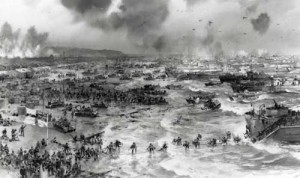
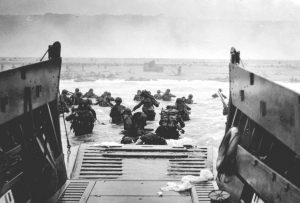 Quebec Conference.
Quebec Conference.
According to the museum’s director and curator, the documents are “convincing and some of the artifacts are considered invaluable” to the museum. He called the personal items which were specially made for the conference, “a great witness of this event of national significance.”
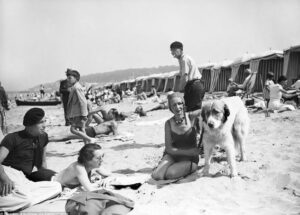
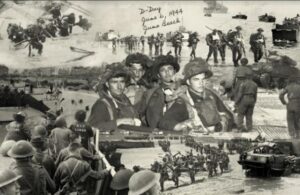 Over the years, many people have collected postcards. Some like them for the scenic views, and some collect postcards that have been sent to them, saving them as mementos of family members who won’t always be with us. I have picked up lots of postcards for my sister, Cheryl Masterson, who has a collection. While this is a cool way to get great pictures of amazing places, postcards were once used as…intel.
Over the years, many people have collected postcards. Some like them for the scenic views, and some collect postcards that have been sent to them, saving them as mementos of family members who won’t always be with us. I have picked up lots of postcards for my sister, Cheryl Masterson, who has a collection. While this is a cool way to get great pictures of amazing places, postcards were once used as…intel.
Starting in 1942, as the BBC, as part of their planning of the D-Day attack, issued a public appeal for postcards and photographs of mainland Europe’s coast, from Norway to the Pyrenees. The British people were eager to help and began sending in postcards and pictures from their trips to France. Other families began searching through boxes of family photos, searching for anything that might show the beaches. Photos of kids building 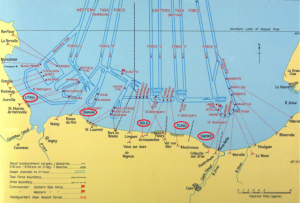 sandcastles, and people lounging on the beach flooded the BBC offices. While it all seemed like a fun project, the people had no idea that their family photographs would prove very instrumental in the D-Day landings. Within 36 hours, over 30,000 packs of pictures of the French coast arrived at the BBC offices. Even more incredible was the fact that by 1944, 10 million holiday snaps and postcards, hotel brochures, letters and guidebooks had arrived by post. Once there, the postcards and photographs were sorted, and the best ones were pinned to a board in a top-secret planning room. Then the army bosses began to study every inch of the beaches and landing areas where the Normandy invasion would go on to take on June 6, 1944.
sandcastles, and people lounging on the beach flooded the BBC offices. While it all seemed like a fun project, the people had no idea that their family photographs would prove very instrumental in the D-Day landings. Within 36 hours, over 30,000 packs of pictures of the French coast arrived at the BBC offices. Even more incredible was the fact that by 1944, 10 million holiday snaps and postcards, hotel brochures, letters and guidebooks had arrived by post. Once there, the postcards and photographs were sorted, and the best ones were pinned to a board in a top-secret planning room. Then the army bosses began to study every inch of the beaches and landing areas where the Normandy invasion would go on to take on June 6, 1944.
The families who sent in their family photographs and postcards, had no idea what would come of their contribution. They weren’t told why their pictures were needed, just that it was an important project. Looking at the photographs now, the innocent snaps almost bring a feeling of deep sadness. Nevertheless, the photographs and postcards were instrumental and extremely important to the war effort. After looking at all the 
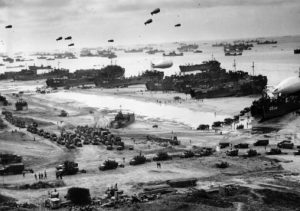 pictures, it was decided that the best place to carry out their plan was on the beaches at Normandy, France. Many of these postcards were used in briefings with officers, land craft operators and other infantry soldier to study and orient themselves based on their drop locations of the building and landmarks in these photos. Of course, the rest is history, and the operation to storm the beaches at Normandy was a great success.
pictures, it was decided that the best place to carry out their plan was on the beaches at Normandy, France. Many of these postcards were used in briefings with officers, land craft operators and other infantry soldier to study and orient themselves based on their drop locations of the building and landmarks in these photos. Of course, the rest is history, and the operation to storm the beaches at Normandy was a great success.
 I suppose I could be wrong, but I don’t recall ever seeing my uncle, Jim Richards get mad at anyone. He had always been a man with a gentle spirit, and one who is patient and kind to all the kids. I suppose his family might be able to sight a few times when I could be proven wrong, but I certainly don’t know of any. Uncle Jim is a quiet man, who could be just a little bit on the shy side, but when you talk to him, you can see the gentleness that lives inside him. He is soft-spoken and always there to help anyone who has a need. Many people would equate him to a big teddy bear, and I would have to agree with them. Uncle Jim has just that kind of personality.
I suppose I could be wrong, but I don’t recall ever seeing my uncle, Jim Richards get mad at anyone. He had always been a man with a gentle spirit, and one who is patient and kind to all the kids. I suppose his family might be able to sight a few times when I could be proven wrong, but I certainly don’t know of any. Uncle Jim is a quiet man, who could be just a little bit on the shy side, but when you talk to him, you can see the gentleness that lives inside him. He is soft-spoken and always there to help anyone who has a need. Many people would equate him to a big teddy bear, and I would have to agree with them. Uncle Jim has just that kind of personality.
Uncle Jim is a very caring man. He is always willing to help anyone who needs his help. He has taken care of various family members over the years, especially his mom. Uncle Jim’s dad passed away when he was young, and only a year after one of his brothers was killed during the D-Day invasion at Normandy, France. Uncle Jim’s caring spirit took over then, and he did whatever he could to help his mom and the rest of his siblings. He was just a young boy at the time. From that day forward, Uncle Jim worked very hard to do things in his life that he knew would make is dad proud of the man he was to become. he could have decided that since his dad was gone, he could act out, but he didn’t. He showed respect for his dad, by taking care of his mom, working hard, and taking care of others too. I can almost picture his 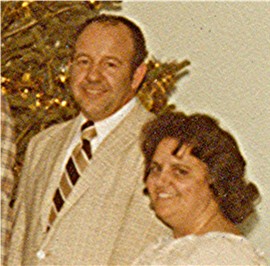 dad looking down from Heaven on his son and smiling with pride at just how great he turned out. It’s definitely something to be proud of.
dad looking down from Heaven on his son and smiling with pride at just how great he turned out. It’s definitely something to be proud of.
When Uncle Jim married my Aunt Dixie, he became my uncle, and a beloved member to our family. He has taken great care of his family, being there to help with transport of the grandchildren, and paying bill when his kids were at work and couldn’t get there to pay them. He helped out when Aunt Dixie ran a daycare and helped with the animals they had on their little place in the country. Uncle Jim was always someone that the family could count on, and we are all glad he is a part of our family. Today is Uncle Jim’s 85th birthday. Happy birthday Uncle Jim!! Have a great day!! We love you!!
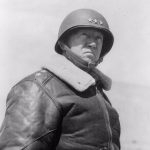 In the final years of World War II, both the Allied and Axis Powers knew that there was no chance of defeating Hitler without cracking his grasp on Western Europe, and both sides knew that Northern France was the obvious target for an amphibious assault. Hitler’s army seemed to be everywhere. That said, the Allied forces knew they had to come up with a way to “fool” the leader of the Third Reich. Hitler arrogantly thought that he knew what the Allied forces were planning, and that was the best way to create his downfall. The German high command assumed the Allies would cross from England to France at the narrowest part of the channel and land at Pas-de-Calais. The Allies used that to their advantage and decided on the beaches of Normandy…some 200 miles to the west. The beaches of Normandy could be taken as they were, but if the Germans added to their defense by moving their reserve infantry and panzers to Normandy from their garrison in the Pas-de-Calais region, the invasion would be a disaster.
In the final years of World War II, both the Allied and Axis Powers knew that there was no chance of defeating Hitler without cracking his grasp on Western Europe, and both sides knew that Northern France was the obvious target for an amphibious assault. Hitler’s army seemed to be everywhere. That said, the Allied forces knew they had to come up with a way to “fool” the leader of the Third Reich. Hitler arrogantly thought that he knew what the Allied forces were planning, and that was the best way to create his downfall. The German high command assumed the Allies would cross from England to France at the narrowest part of the channel and land at Pas-de-Calais. The Allies used that to their advantage and decided on the beaches of Normandy…some 200 miles to the west. The beaches of Normandy could be taken as they were, but if the Germans added to their defense by moving their reserve infantry and panzers to Normandy from their garrison in the Pas-de-Calais region, the invasion would be a disaster.
In what would become an ingenious plan, the Allied intelligence services created two fake armies to keep the Germans on their toes. One would wonder how they proposed to pull that off. The Allies created two “Ghost Armies.” One would be based in Scotland to create a supposed invasion of Norway and the other headquartered 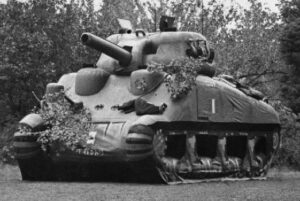 in southeast England to threaten the Pas-de-Calais. While the operation in Scotland relied mainly on fake radio traffic and the feeding of false information to double agents to create the impression of a substantial army, the southern “Ghost Army” had to seem much more real. The fortitude South was well within the range of prying German ears and eyes, so fake chatter alone would be uncovered too quickly. It had to look and sound like a substantial army was building up in southeast England. They needed boots on the ground there, without actually using too much of their precious manpower. That seems like a monumental task.
in southeast England to threaten the Pas-de-Calais. While the operation in Scotland relied mainly on fake radio traffic and the feeding of false information to double agents to create the impression of a substantial army, the southern “Ghost Army” had to seem much more real. The fortitude South was well within the range of prying German ears and eyes, so fake chatter alone would be uncovered too quickly. It had to look and sound like a substantial army was building up in southeast England. They needed boots on the ground there, without actually using too much of their precious manpower. That seems like a monumental task.
Enter George and his imaginary men. Patton was put in charge of leading a fake army, commonly known as the “Ghost Army” as part of a massive counterintelligence operation preceding D-Day. The “Ghost Army” was an army of inflatable tanks, rubber airplanes, and fake radio signals designed to trick the German army. The mission was insanely successful. The “Ghost Army” was a United States Army tactical deception unit used during World War II officially known as the 23rd Headquarters Special Troops. The 1100-man unit was given a 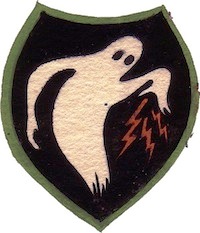 unique mission within the Allied Army. Their orders…impersonate other Allied Army units to deceive the enemy. It was simple, but it wouldn’t be easy.
unique mission within the Allied Army. Their orders…impersonate other Allied Army units to deceive the enemy. It was simple, but it wouldn’t be easy.
By the evening of June 6, 1944, in what would become known as D-Day, the First Army landed at Normandy. The battle was on, and without the extra troops Hitler might have sent if he wasn’t misled so completely. By June 23, 1945, the 23rd Headquarters Special Troops was on its way home after having served with four US armies through England, France, Luxembourg, Belgium, Holland, and Germany. During their tenure, they put on what many would call a “traveling road show” utilizing inflatable tanks, sound trucks, fake radio transmissions, scripts, and pretense. They staged more than 20 battlefield deceptions, often operating very close to the front lines. While their missions and their work were amazing, their story was kept secret for more than 40 years after the war, until it was declassified in 1996.
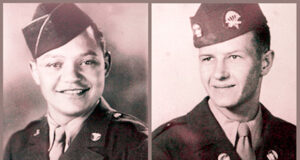 There were a number of events that took place on June 6, 1944, also known as D-Day. The areas of the Allied attack were miles away from each other. Early that morning, the Allies dropped thousands of allied paratroopers behind enemy lines in anticipation of the invasion of Normandy. It seems a strange idea to drop them behind enemy lines…like it was a big mistake. Nevertheless, one of the main objectives of the 101st Airborne was to capture the small village of Angoville-au-Plain. Then, when intense fighting broke out over the village, they dropped two American medics, Robert Wright and Kenneth Moore, in to set up a medical station in the tiny town
There were a number of events that took place on June 6, 1944, also known as D-Day. The areas of the Allied attack were miles away from each other. Early that morning, the Allies dropped thousands of allied paratroopers behind enemy lines in anticipation of the invasion of Normandy. It seems a strange idea to drop them behind enemy lines…like it was a big mistake. Nevertheless, one of the main objectives of the 101st Airborne was to capture the small village of Angoville-au-Plain. Then, when intense fighting broke out over the village, they dropped two American medics, Robert Wright and Kenneth Moore, in to set up a medical station in the tiny town 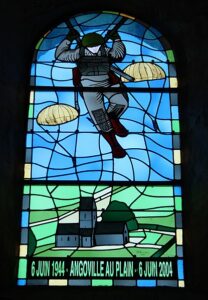 church. So, now they had not only had troops behind the lines, but they have medics…without guns behind the lines too.
church. So, now they had not only had troops behind the lines, but they have medics…without guns behind the lines too.
The plan to take over the village worked quickly and well. United States paratroopers established control of Angoville-au-Plain, but just as quickly, German units counterattacked and forced American troops back. Because of multiple injuries, Wright and Moore stayed behind. Suddenly they found themselves in danger when German soldiers entered the church. At first the German soldiers were hostile to the Americans, but then they realized that the medics were treating their wounded, as well the Allied wounded. The German troops could have attacked the men, and walked away without penalty, but instead, they left, posting a Red Cross flag at the entrance.
The fighting in the area raged on for three days, and the village changed hands several times, but the two medics never missed a beat. Over the course of the three days, they saved 80 lives, including a local teenager. The amazing part of the whole thing wasn’t just that they saved the lives, but also that the German soldiers didn’t kill them 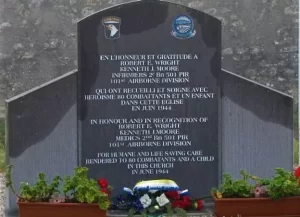 in the first place. I’m sure the medics thought that was an amazing thing. The little village of Angoville-au-Plain thought is was amazing too…not just the work of the medics, but also the work of the 101st Airborne. They thought it was amazing enough to make sure it was remembered
in the first place. I’m sure the medics thought that was an amazing thing. The little village of Angoville-au-Plain thought is was amazing too…not just the work of the medics, but also the work of the 101st Airborne. They thought it was amazing enough to make sure it was remembered
Today, all of the stained glass windows in the church (the originals were destroyed in the battle) are tributes to Wright, Moore, and the 101st Airborne. Wright visited the church in 2004, and some of his ashes were spread in Angoville-au-Plain’s cemetery as per his request, following his death on December 21, 2013. Moore passed away on December 7, 2014.
 We don’t often think of generals feeling anguish over men lost in the battles they are sent to fight. It’s not that we don’t realize that they feel bad for sending these men into battle, to their possible deaths, even to their probable deaths, because we do. Still, they are the generals, and far above the rank and file…the little guys. Generals, Admirals, the President…could they even realize the consequences of their decisions in the lives of the people under them? I think most of us somehow think that the generals and even the president have no idea how many people they are condemning to death by the orders they give. In reality, nothing could be further from the truth.
We don’t often think of generals feeling anguish over men lost in the battles they are sent to fight. It’s not that we don’t realize that they feel bad for sending these men into battle, to their possible deaths, even to their probable deaths, because we do. Still, they are the generals, and far above the rank and file…the little guys. Generals, Admirals, the President…could they even realize the consequences of their decisions in the lives of the people under them? I think most of us somehow think that the generals and even the president have no idea how many people they are condemning to death by the orders they give. In reality, nothing could be further from the truth.
General Eisenhower, known as “Ike” was the one with the final say in the D-Day attack that could potentially take the lives of more than 160,000 men, as well as the possible destruction of nearly 12,000 aircraft, almost 7,000 sea vessels. The attack was supposed to take place on June 5, 1944, but the weather was not cooperative. For the attack to work, several factors had to be optimally in favor of the Allies. Nevertheless, these were factors that could not be controlled by humans. Things like the tides, the moon, and the weather. They needed low tide and bright lunar conditions, limiting the possibilities to just a few days each month. The dates for June 1944 were the fifth, the sixth, and the seventh. It was a very small window, and then the weather on the fifth didn’t cooperate either. If the attack was not launched on one  of those dates, Ike would be forced to wait until June 19 to try again. Not only did that mean more deaths because of the German occupation, but keeping the attack secret was harder, the longer they had to wait.
of those dates, Ike would be forced to wait until June 19 to try again. Not only did that mean more deaths because of the German occupation, but keeping the attack secret was harder, the longer they had to wait.
Finally, it looked like June 6, 1944 was going to cooperate. All of his advisors told him that their part was a go. Finally it was time for the final decision…one that belonged only to Eisenhower. He labored over the decision. It was not one where he could decide from his lofty position and never think about it again. He knew that he was sending men to their deaths…to certain death. He couldn’t pass the buck. He couldn’t call a dozen people to see how they felt about it. He had to decide. And so he did. History has argued what his exact words were, some said, “Ok, let ‘er rip.” or “Well, we’ll go” or “All right, we move” or “OK, boys, We will go.” or “We will attack tomorrow.” I don’t suppose it really matters what he said exactly, but rather, it mattered what happened after. We now know that the Allied casualties on June 6 have been estimated at 10,000 killed, wounded, and missing in action. Among those were 6,603 Americans, 2,700 British, and 946 Canadians. It ended with an Allied victory, but it was not without cost…the loss of lives was great. Eisenhower could not “celebrate” the anniversary of D-Day, thinking that it would be like patting himself on the back, but I think that the biggest  picture of the weight that the attack placed on Eisenhower was when he was going to a reunion with the 82nd Airborne Division. Upon seeing him, the men stood, cheering and whistling. Reporter Val Lauder had spoken to him, and later watched the news broadcast of the reunion, when her mother noticed something odd. Says Lauder, “My mother, watching with me, said, ‘He’s crying. Why is he crying?’ I said, ‘He’s looking out at a roomful of men he once thought he could be sending to their death.'” That says it all. Ike didn’t just pull the plug and send those men to their deaths…never giving it another thought. The decision haunted him for years, and quite likely the rest of his life.
picture of the weight that the attack placed on Eisenhower was when he was going to a reunion with the 82nd Airborne Division. Upon seeing him, the men stood, cheering and whistling. Reporter Val Lauder had spoken to him, and later watched the news broadcast of the reunion, when her mother noticed something odd. Says Lauder, “My mother, watching with me, said, ‘He’s crying. Why is he crying?’ I said, ‘He’s looking out at a roomful of men he once thought he could be sending to their death.'” That says it all. Ike didn’t just pull the plug and send those men to their deaths…never giving it another thought. The decision haunted him for years, and quite likely the rest of his life.
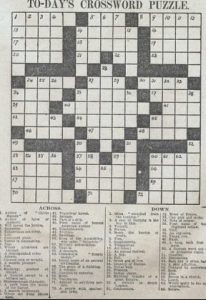 As the Allies were planning the massive D-Day assault which was intended to end World War II in Europe, some strange “coincidences” happened that almost threw a monkey wrench into the whole thing. The planned assault on Normandy, France, in 1944, was to include over 5,000 ships, 1,200 planes, and almost 160,000 men. They were set to invade Europe from the British Isles, when something almost put a stop to it…a series of crossword puzzles. Personally, I hate crossword puzzles. They are boring in my mind, so if I were to find a clue in one, it would likely be a miracle.
As the Allies were planning the massive D-Day assault which was intended to end World War II in Europe, some strange “coincidences” happened that almost threw a monkey wrench into the whole thing. The planned assault on Normandy, France, in 1944, was to include over 5,000 ships, 1,200 planes, and almost 160,000 men. They were set to invade Europe from the British Isles, when something almost put a stop to it…a series of crossword puzzles. Personally, I hate crossword puzzles. They are boring in my mind, so if I were to find a clue in one, it would likely be a miracle.
The problem began with the Dieppe Raid on August 19th, 1942. Dieppe is also in Normandy, but further North. In Dieppe, over 6,000 Allied troops, mostly from Canada, attacked at 5 AM. “They had four main goals: (1) to prove that it was possible to capture a slice of Nazi-occupied Europe, (2) to boost Allied morale, (3) to gain intelligence, and (4) to destroy coastal defenses and other sensitive installations.” The mission failed miserably, with the loss of, capture of, or retreat of almost 60% of the invading forces by 3 PM. This couldn’t have been just coincidental, and the Allies wanted to know what had happened. It seemed quite likely that the Germans had been warned of the attack. How could this have happened. Somehow, the suspicion fell on The Daily Telegraph, a British paper still in business today. I’m sure there were a number of newspapers over the years that were used to pass coded messages to the enemy. And I guess it would take a spy’s mind to figure it all out. It had to be discreet, because the paper can’t just give advance warning notice to the enemy, but they did (and still do) have a crossword puzzle section. What better avenue for coded messages. The thing that really triggered suspicion was that two days before the Dieppe invasion, the clue, “French port” was given. And the solution was “Dieppe,” given the following day…the day before the invasion. When I think about the 6,000 men that walked into an ambush because of that one puzzle, I feel furious. This wasn’t a coincidence, this was deliberate, and it was criminal.
The intelligence personnel quickly focused on Leonard Sydney Dawe…the headmaster of Strand School, who was responsible for the crossword puzzle. They were surprised to think it might be him, because he was a veteran of World War I. In addition, nothing linked him to Nazi Germany. In the end, MI5 concluded that it was just that a chilling coincidence, but was it…really? The Strand School for boys in south London, which no longer exists, still stuck out as being somehow involved. It was learned that when the Germans began their bombardment of the city in 1939, Strand was moved to Effingham in Surrey, which was close to where many American and Canadian forces were based.
The French invasion was called Operation Overlord. It was to take place on June 5th, 1944 and involve a series of joint sea and air landings along the Normandy coast. Rather than mass themselves at one spot, however, they were to land at five different areas according to nationality. The Americans were to land at two places. The first was on the left bank of the Douve estuary…codenamed Utah Beach. The second was the stretch which included Sainte-Honorine-des-Pertes, Saint-Laurent-sur-Mer, and Vierville-sur-Mer…referred to as Omaha. The  British were also given two landing sites – the first along Saint-Aubin-sur-Mer to Ouistreham…Sword Beach, as well as the strip from Arromanches-Les-Bains, Le Hamel, and La Rivière…Gold Beach. As for the Canadians, they were assigned the stretch from Courseulles, Saint-Aubin, and Bernières…Juno Beach. To ensure the quick off-loading of cargo, portable bridges called “Mulberry Harbors” were built. Ships would tow these to France, assemble them at sea, then drive equipment onto the beaches.
British were also given two landing sites – the first along Saint-Aubin-sur-Mer to Ouistreham…Sword Beach, as well as the strip from Arromanches-Les-Bains, Le Hamel, and La Rivière…Gold Beach. As for the Canadians, they were assigned the stretch from Courseulles, Saint-Aubin, and Bernières…Juno Beach. To ensure the quick off-loading of cargo, portable bridges called “Mulberry Harbors” were built. Ships would tow these to France, assemble them at sea, then drive equipment onto the beaches.
The massive size of the invasion, made it almost impossible to keep a complete secret from the Germans, so the plan was to keep them guessing as to exactly when and where the invasion would take place. It was then that the Allies launched Operation Bodyguard…a series of diversions which convinced the Germans that Normandy was simply a distraction, while the main invasion was to take place elsewhere. The Germans bought it, they didn’t want to take any chances. As a result, they stretched their forces thin in a desperate attempt to cover all of their bases. To keep them off balance, absolute secrecy was vital.
Then, in February 1944, one of The Daily Telegraph’s crossword answers was “JUNO.” The following month, it was “GOLD,” and the month after that, it was “SWORD.” Coincidence? MI5 thought so. Then, when the next puzzle included the clue, “One of the US,” they began to wonder. The next day, the answer given was “UTAH.” This was really too much, and MI5 was getting worried. As soon as the May 22nd edition came out, MI5 anxiously grabbed a copy. Scanning the crossword section, they found yet another suspicious clue…“Red Indian on the Missouri River.” And what was the answer given the next day? “OMAHA.” Lets just say, they were getting nervous. Still, it got worse. The May 27th edition had another damning clue…“Big-Wig.” And the answer was? “OVERLORD.” The clincher came on June 1…four days before lift-off. The solution to 15 Down was “NEPTUNE.”
Dawe was arrested at his school to the astonishment of the students and staff. They then banned the paper’s next publication in case “DDAY” appeared in the next crossword. The US Coast Guard manned USS LST-21 unloads British Army tanks and trucks onto a “Rhino” barge during the early hours of the invasion on Gold Beach, 6 June 1944. Dawe was released after the invasion but refused to speak about his ordeal till 1958. He admitted that they did turn him “inside-out,” and had D-Day turned into another Dieppe, he might have been shot. Many people thought it was all just a coincidence…at least till 1984 when Ronald French, a former student at Strand, came forward. As it turns out, Dawe didn’t create crossword puzzles. He instead had students arrange words on a grid, and when he was satisfied, provided clues to solve them by. Then he’d send the finished work to the paper, taking credit for the work. According to French and other former students who later came forward, everyone in Surrey knew the code words. It seems that because they all hung around the Americans and Canadians, the words had leaked out. The French didn’t know what the words meant, only that the servicemen often said them. So when told to work on the crossword puzzles, he included the codes. After his release, Dawes confronted French and accused him of putting the entire country at risk, but how had this  happened. It seems that despite their own secrecy, the MI5 had apparently forgotten to tell the army to keep their mouths shut. It all came about because when the Allies believed that the war was turning in their favor, the Third Washington Conference…also called the Trident Conference…was held in Washington, DC in May 1943. It was there that plans for an Allied invasion of Sicily, France, and the Pacific were discussed. The careless soldiers that spilled the code words almost cost the Allies the victory. D-Day was a battle that cost the Allies many lives, but it could have been much worse, if the secrets had been passed to the enemy in a way that they could have understood them.
happened. It seems that despite their own secrecy, the MI5 had apparently forgotten to tell the army to keep their mouths shut. It all came about because when the Allies believed that the war was turning in their favor, the Third Washington Conference…also called the Trident Conference…was held in Washington, DC in May 1943. It was there that plans for an Allied invasion of Sicily, France, and the Pacific were discussed. The careless soldiers that spilled the code words almost cost the Allies the victory. D-Day was a battle that cost the Allies many lives, but it could have been much worse, if the secrets had been passed to the enemy in a way that they could have understood them.
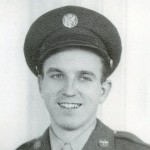
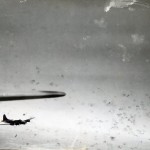 As I have researched the infantry soldiers of World War II, my thought was that I was really thankful that my dad, Allen Spencer was not one of those men on the ground during the fighting. I felt bad for those men who were on the ground, fighting from the foxholes. I still do, because they were in constant danger. Bombs fall from the sky, and bullets fly from across the battlefield. If those things didn’t kill a soldier, the freezing cold, trench foot, or dysentery from the horribly unsanitary conditions could. It seemed that my dad’s situation was by far safer, but now, I’m not so sure that’s true.
As I have researched the infantry soldiers of World War II, my thought was that I was really thankful that my dad, Allen Spencer was not one of those men on the ground during the fighting. I felt bad for those men who were on the ground, fighting from the foxholes. I still do, because they were in constant danger. Bombs fall from the sky, and bullets fly from across the battlefield. If those things didn’t kill a soldier, the freezing cold, trench foot, or dysentery from the horribly unsanitary conditions could. It seemed that my dad’s situation was by far safer, but now, I’m not so sure that’s true.
The book I had been listening to, that took in World War II from D-Day to The Battle of the Bulge, talked mostly about the ground war, but then at the end, the reader said something that really struck me. It was about the look that crossed the face of a bomber crew’s faces before certain missions…those that would inevitably find the plane flying through flak. The look was one of fear. I knew flak was dangerous, but somehow I didn’t really connect flak with bringing down a plane, or seriously injuring its occupants. Nevertheless, it is quite dangerous for them.
As I researched the dangers of flak, a shocking revelation made itself known. I had written a story about the life expectancy of the ball turret gunner. My findings were that that life expectancy was about 12 seconds. That may be true when one is talking about the prospect of being shot, but when it comes to flak, that cannot be said. Apparently, where flak is concerned, the best place to be is in the plexiglass structure of the ball turret. Plexiglass holds up better against flak than other areas of the plane, so the ball turret gunner is much more protected…at least from flak. The same cannot be said for the bullets flying through the area. I was thankful that my dad was not a ball turret gunner, and that he only filled in as a waist gunner periodically. The waist gunners were in the open, where protection from bullets, and from flak was minimal…at best, non-existent at worst. I can’t imagine how those memories must have affected my dad, but in the book I listened to, the main reason many of the men didn’t want to talk about their experiences in World War II, or any war, was because talking about it brought those memories flooding in again.
After researching flak, and how it works, I can see why the men would get a look of fear on their faces as they prepared to go through areas anti-aircraft weapons shooting flak into the air. Some men said that they could see the red hot glow in the center of the flak, if it was very close. That tells me that it was like a small explosive devise. No wonder it could bring so much damage to a plane. I had known that flak could put holes in the fuselage, but somehow I hadn’t tied that with bringing down a plane. I surmise that it was the B-17 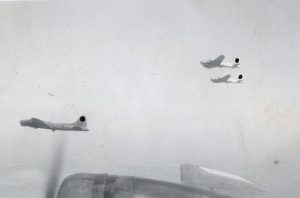
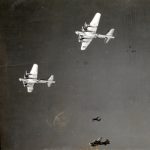 bomber top turret gunner’s daughter in me that wouldn’t allow me to place that danger around my dad. I didn’t want to think about the dangers of his every mission in World War II. My mind seems to have placed his plane in a bubble or a force field, so that no danger could come near him. I think every veteran wonders why they were spared, when others didn’t make it back home. I don’t think anyone can answer that question. As a Christian, I have to credit God for bringing my future dad home.
bomber top turret gunner’s daughter in me that wouldn’t allow me to place that danger around my dad. I didn’t want to think about the dangers of his every mission in World War II. My mind seems to have placed his plane in a bubble or a force field, so that no danger could come near him. I think every veteran wonders why they were spared, when others didn’t make it back home. I don’t think anyone can answer that question. As a Christian, I have to credit God for bringing my future dad home.

